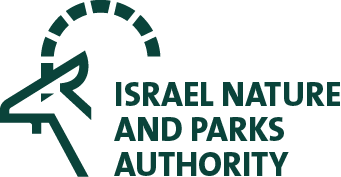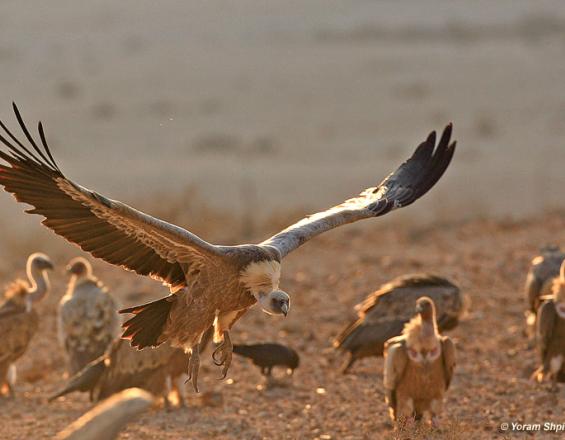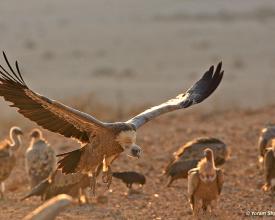
Un innovador sistema automático de alerta en tiempo real basado en la localización para prevenir el envenenamiento de animales salvajes mediante buitres leonados marcados con GPS ha permitido mejorar la conservación de especies amenazadas en zonas prot...

El envenenamiento ilegal por agricultores descontentos con el objetivo de matar a los chacales que dañan los cultivos y el ganado es una gran amenaza para la fauna salvaje. Se colocan cebos envenenados en los cadáveres, lo que provoca envenenamientos a gran escala que dañan todo el ecosistema.
Para ayudar a la detección precoz, hemos innovado un sistema de alerta que analiza automáticamente en tiempo real la ubicación, altitud, temperatura corporal y velocidad de los buitres a partir de sus etiquetas GPS. A continuación, determina la probabilidad de envenenamiento cuando los datos del GPS muestran un comportamiento coherente con el descenso de un buitre sobre un cadáver. A continuación, realiza la georreferenciación en zonas propensas al envenenamiento y envía alertas automáticas de Telegram sólo al guarda regional pertinente con la ubicación exacta. Todo ello en pocos segundos, lo que permite una respuesta rápida sobre el terreno, evitando posibles envenenamientos.
Hasta donde sabemos, este es el único sistema automático de alerta en tiempo real para encontrar cadáveres basado en carroñeros marcados que funciona con éxito sobre el terreno.
Contexto
Défis à relever
El envenenamiento ilegal de la fauna salvaje es una gran amenaza en todo el mundo. Un reto importante es la detección rápida de los cebos. Bulgaria e Israel pensaron por su cuenta en utilizar los datos de los buitres para detectar cadáveres. Nosotros resolvimos el problema de la interpretación rápida de los datos del GPS para determinar la probabilidad de que hubiera un cadáver y, a continuación, cómo llevar a un guarda forestal hasta allí. Nuestro sistema avanzado y automatizado resuelve la disyuntiva entre la necesidad de una respuesta rápida y el tiempo limitado de los guardas, reduciendo las falsas alarmas y alertando sólo a los guardas pertinentes. También incorpora un sistema de supervisión que registra todas las alertas y respuestas para su seguimiento. Además, la recogida de cadáveres reduce el alimento disponible para los carroñeros y disminuye eficazmente la población sin necesidad de sacrificio.
Compramos camiones 4x4 especiales con cabestrantes para retirar los cadáveres del campo y llevarlos a las instalaciones designadas para su eliminación.
El sistema toma el comportamiento natural del animal salvaje y, mediante una serie de pasos tecnológicos, lo transforma en un método eficaz para proteger el ecosistema.
Ubicación
Procesar
Resumen del proceso
Los 6 componentes básicos se enumeran como etapas del sistema completo.
Los buitres son marcados y sus datos se envían de forma continua y automática en tiempo real al sistema, donde los algoritmos determinan si los datos de comportamiento indican la probabilidad de que se trate de un cadáver. En caso afirmativo, el sistema envía una alerta al guarda forestal adecuado y éste responde. Una vez en el lugar, el guarda tiene que seguir el protocolo para retirar el cadáver y, si es necesario, ocuparse del caso de caza furtiva. Al final, el supervisor recibe un informe de todas las alertas enviadas y las respuestas.
Bloques de construcción
Los buitres marcados con GPS envían datos
Para recibir datos GPS, es necesario que haya un número determinado de aves con etiquetas adecuadas que transmitan datos en tiempo real.
Factores facilitadores
- personal experimentado para capturar y marcar buitres
- respaldo financiero para adquirir las marcas y los datos
Lección aprendida
Cuantas más aves marcadas haya, más amplia será la cobertura y mayor el éxito.
Los registradores avanzados reciben datos GPS
- Integración de los datos de posición, altitud, velocidad y temperatura de los transmisores Orintela con el sistema de información INPA.
Factores facilitadores
- Profesionales de TI y desarrolladores
- aportación de Ornitela
Lección aprendida
La información del fabricante del transmisor ayuda a integrarlo con los sistemas domésticos.
Algoritmos de probabilidad de cadáver y necesidad de alerta
Algoritmos específicos procesan los datos GPS sobre posición, altitud, velocidad y temperatura y consideran toda la zonificación como áreas propensas al envenenamiento (basándose en el uso del suelo para pastoreo y en sucesos anteriores) para determinar si es necesaria la alerta.
Los algoritmos deben descartar que el buitre descienda sobre un acantilado o un nido, e incluir sólo el descenso sobre zonas en las que la probabilidad de cadáver sea mayor (en función de la inclinación del terreno).
El algoritmo calcula la inclinación del terreno en el punto de descenso y la añade a la determinación de la probabilidad de envenenamiento.
Factores facilitadores
- se necesitan excelentes datos detallados del SIG sobre las características del terreno y la topografía
- muchos datos sobre intoxicaciones anteriores
- datos sobre el uso del suelo (pastizales o cultivos)
Lección aprendida
- Las capas topográficas de alta resolución son muy importantes para descartar que los buitres aterricen en lugares poco probables
El sistema enlaza con la aplicación Telegram para enviar alertas a los guardas pertinentes
Cuando los algoritmos determinan que es necesaria una alerta, la envían únicamente a los guardas de guardia cercanos a través de la aplicación Telegram de sus teléfonos inteligentes.
Factores facilitadores
- integración del sistema de alerta con la posición del guarda forestal en tiempo real y su estado de guardia (activo o fuera de servicio)
- integración con el sistema Telegram
- integración con Waze u otra app de solución de conducción basada en GPS
Lección aprendida
Telegram es lo mejor para enviar alertas.
Centrar las alertas solo en los guardias pertinentes reduce las falsas alarmas innecesarias y mejora la eficacia de las respuestas reales.
Los guardabosques retiran el cadáver y se ocupan del envenenamiento
- Una vez que el guarda forestal llega al lugar, tiene que prepararse para retirar el cadáver del campo, normalmente llamando al camión de campo del INPA.
- Si hay animales heridos en el lugar, deben recibir rápidamente primeros auxilios y atención veterinaria.
- Si el cadáver está envenenado, debe asegurarse para evitar el acceso de más animales.
- Hay que buscar más animales en el lugar.
- Todo el lugar debe tratarse también como la escena de un crimen, de modo que se conserven y recojan cuidadosamente las pruebas forenses y de investigación.
Factores facilitadores
- Formación o protocolos adecuados para tratar los casos de intoxicación.
- Sistema de radio o teléfono adecuado para todas las áreas
- Tractor o vehículo 4X4 capaz de retirar los cadáveres de los animales del campo
- Veterinarios de guardia en todas las zonas para recibir animales envenenados
Lección aprendida
Es importante contar con una formación adecuada y poner en práctica los protocolos de actuación en caso de intoxicación.
Impactos
El envenenamiento ilegal ha provocado en los últimos años el declive de buitres leonados, especie en peligro crítico de extinción. Al ser un importante carroñero, evitar su envenenamiento favorece servicios ecosistémicos cruciales y mejora la salud ambiental de la fauna silvestre y también de las personas.
Los cadáveres envenenados no sólo perjudican a los buitres leonados marcados, sino también a otras especies amenazadas. Así pues, nuestro sistema ha tenido un efecto positivo muy amplio en la reducción de los casos de envenenamiento, directa e indirectamente a través de la cadena alimentaria.
El sistema de alerta permite una respuesta rápida sobre el terreno y la retirada de los cadáveres. Incluso cuando no están envenenados, el traslado de los cadáveres del campo a los comederos de buitres reduce la disponibilidad de alimento para los chacales sobreabundantes, reduciendo su capacidad de carga y el tamaño de la población sin necesidad de sacrificios letales. La reducción de chacales disminuye los conflictos entre humanos y fauna salvaje y reduce en gran medida los costes de depredación y daños a los cultivos. Los buitres recogen las carcasas en lugares controlados.
Este proyecto es una solución basada en la naturaleza en sentido literal; permite mejorar la gestión de las zonas protegidas basándose en los datos sobre el comportamiento de los propios animales.
Beneficiarios
- Especies silvestres amenazadas y protegidas
- Agricultores - reducción de los conflictos entre el hombre y la fauna salvaje
- Solución basada en la naturaleza
- Salud humana - saneamiento (eliminación de cadáveres)
Objetivos de Desarrollo Sostenible
Historia
Fue con las primeras luces del día, poco después de las 5 de la mañana, el 9 de mayo de 2019, cuando el guarda forestal del INPA Uria Vazana se despertó de repente de un profundo sueño por una estridente llamada procedente de su smartphone. No era el timbre habitual del teléfono, y su mente nublada por el sueño tardó unos segundos en darse cuenta de lo que era. Era una alerta del programa de detección automática de buitres que le informaba de que un buitre leonado equipado con una etiqueta GPS había descendido del cielo cercano de una forma que el algoritmo había interpretado como que había bajado del cielo sobre un cadáver.
Desde luego, no era la primera vez que recibía una alerta de este tipo, así que ya había aprendido que el sistema funciona muy bien. Cuando envía una alerta, casi siempre hay un cadáver fresco que algún buitre ha encontrado.
Aquella mañana, Uria tomó una taza de café y se subió a su jeep con su perro de confianza como compañero. Encendió los faros y partió al amanecer hacia el lugar designado por el sistema en los Altos del Golán, en el norte de Israel.
Nada más llegar, se dio cuenta de que no se trataba sólo de una vaca muerta, sino de algo mucho peor: ¡eran los primeros indicios de un envenenamiento deliberado! Pasó al modo de acción rápida e inmediatamente localizó 8 buitres envenenados en el suelo que seguían vivos. Rápidamente pidió refuerzos y empezó a aplicar el protocolo de actuación en caso de envenenamiento masivo.
Esa mañana, Uria y los otros guardas que llegaron, corrieron con todos los buitres envenenados para recibir atención veterinaria de urgencia, pero sólo 2 sobrevivieron. Uria estaba triste por no haber podido salvarlos a todos, pero sabe sin duda que el sistema de alerta por GPS y su rápida respuesta evitaron definitivamente una escena mucho peor que la que se encontró.
Las búsquedas posteriores en la zona durante los días siguientes mostraron muy pocos animales, y esto se debió principalmente a la rápida respuesta del guarda forestal. Dos chacales envenenados y una hiena rayada era mucho menos de lo que puede ocurrir con un cadáver envenenado, donde a veces hay docenas o incluso cientos de animales muertos.
Desde entonces, los dos buitres que salvó han sido devueltos a la naturaleza, y ahora llevan etiquetas GPS, y también están aportando datos al sistema para ayudar a salvar a otros animales salvajes.
